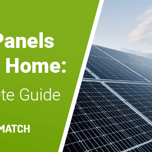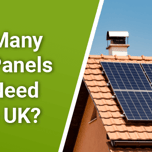Answer these simple questions and we will find you the BEST prices
Which type of solar quotes do you need?
It only takes 30 seconds
100% free with no obligation

Get up to 4 quotes by filling in only 1 quick form

Slash your energy bills by installing solar panels

For the average 2-3 bedroom house
- GreenMatch
- Solar Energy
- Solar Panels
- Roof Tiles
Solar Roof Tiles in the UK: Costs & Benefits (October 2025)

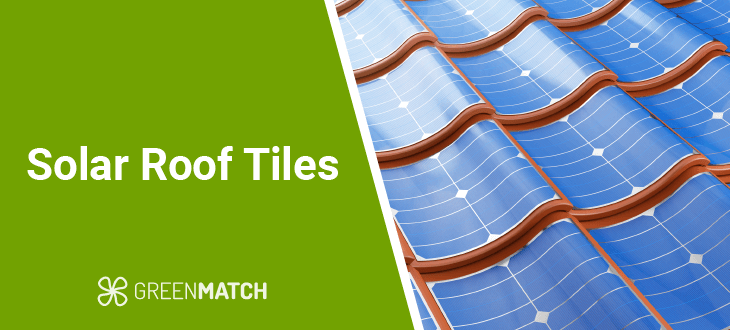
- Solar tiles in the UK cost between £11,000 – £13,500 for the average 2-3 bedroom home while regular solar panels can cost between £6,600 - £8,100.
- The biggest appeal of solar roof tiles is their aesthetically pleasing design. They blend in with the design of your roof and, therefore, won’t disrupt your house style.
- The most popular solar tile providers in the UK are Tesla, GB-Sol, and Solecco.
Solar roof tiles, also known as solar shingles or solar slates, are a relatively new green energy technology. For those committed to sustainable energy generation and wanting to have a solar-powered home, solar roof tiles are worth considering as an alternative to solar panels.
- Quotes from local engineers
- Payment by finance available
- Save up to £1,567 per year
It only takes 30 seconds



What are solar roof tiles?
Put simply, solar roof tiles are solar panels that look like roof tiles. They convert energy from the sun into usable electricity with the help of photovoltaic cells. Much like solar panels, they comprise semi-conducting materials that generate an electric charge and send it to an inverter and eventually a home and/or solar battery.
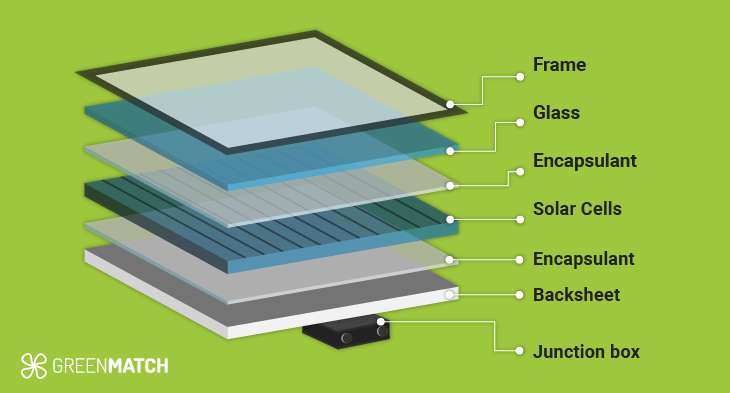
The majority of solar roofing installations happen on new roofs, with retrofits being less common. Reroofing and retrofits can be more labour-intensive and companies like Tesla can provide entire solar roofs as opposed to shingles, which are comparatively easier to integrate into new properties.
The majority of solar roofing installations happen on new roofs, with retrofits being less common. Reroofing and retrofits can be more labour-intensive, and companies like Tesla can provide entire solar roofs as opposed to shingles, which are comparatively easier to integrate into new properties.
Solar tiles vs solar panels
| Solar roof tiles | Solar panels | |
|---|---|---|
| Installation | More complex installation: Roof tiles need to be replaced | Less complex installation: Panels clamp directly onto the roof |
| Cost | More expensive option: £16,100 (2-3 bedroom home) | More affordable option: £5,000 - £6,000 (average 2-3 bedroom home) |
| Efficiency | Less powerful: 10% to 20% efficient | More powerful: 18% to 25% efficient |
| Design | More visually appealing: Modern solar panel roof tiles come in a variety of shapes and sizes. | Less visually appealing: Rest on top of the roof and can be visually disruptive. |
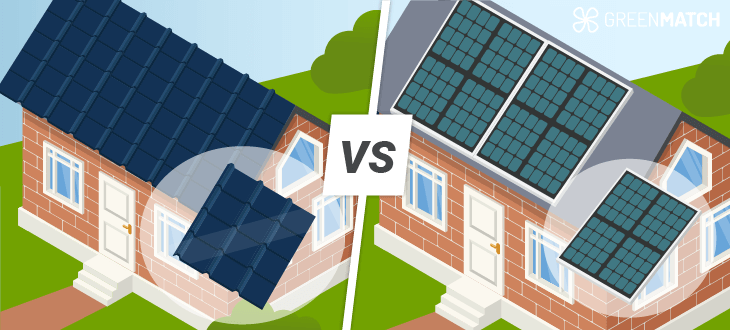
There are some key differences between solar roof tiles and traditional panels. Below we've outlined these differences in some more detail.
Tiles: More complex installation
One major difference between solar tiles and panels lies in the installation process. Solar tiles double as a roofing material to replace existing roof tiles. This requires more time (often over a week) and can cost significantly more compared to panels.
Panels: Less complex installation
Solar panels are mounted directly onto the roof, avoiding the need for significant structural changes. This simpler installation process is quicker, more cost-effective, and often easier to align with local building and hazard regulations.
Tiles: More expensive option
The cost of installing solar tiles is significantly higher, averaging around £16,100 for a 2-3 bedroom home.
Panels: More affordable option
Solar panels are a more affordable choice, typically costing between £5,000 and £6,000 for the average 2-3 bedroom home.
Tiles: Lower energy output per square meter
Solar tiles generally have lower efficiency, typically converting 10% to 20% of sunlight into energy. As a result, they require more surface area to achieve the same power output as solar panels.
Panels: Higher energy efficiency
Solar panels are more efficient, with conversion rates of 18% to 25%. This means they need less space and fewer units to generate the same amount of electricity, making them the ideal option for smaller roofs.
Tiles: More visually appealing
Modern solar tiles come in various designs to match different architectural styles. They can mimic classic Tuscan tiles, concrete, or other traditional roof materials.
Panels: Less visually appealing
Unlike tiles, traditional solar panels are mounted on top of the roof, making them harder to visually integrate. Their bulkier and less refined appearance may not appeal to those prioritising aesthetics.
Cost of solar roof tiles
For a 2-3 bedroom home, the cost of installing solar tiles averages around £16,100 for a 4kW system.
The table below illustrates what solar roof tiles cost in the UK. We have also included standard solar panel prices as a reference.
| Solar roof tile costs | ||||
|---|---|---|---|---|
| Household size | System size | Solar tile cost (Inc. VAT) | Labour cost | Total average cost |
| Small; 1 bedroom | 1kW | £5,500 – £7,000 | £1,800 | £8,050 |
| Small; 1-2 bedrooms | 2kW | £7,000 – £9,000 | £1,900 | £9,900 |
| Small; 1-2 bedrooms | 3kW | £9,000 – £11,000 | £2,000 | £12,000 |
| Medium; 1-2 bedrooms | 4kW | £11,000 – £13,500 | £2,100 | £13,000 |
| Medium; 2-3 bedrooms | 5kW | £14,000 – £16,000 | £2,200 | £16,100 |
The final price depends mainly on the size of the roof and the proportion of the roof you would like to cover with solar slates. You would also have to consider the complexity of the installation process and the installer’s rates. The additional costs can affect the break-even time of your investment.
Insurance options
Solar roof tiles are usually included under standard home building insurance since they are considered part of the property’s structure. This applies to both homeowners and renters, provided the tiles are securely installed.
Additional policies can cover risks excluded from standard insurance, such as installation damage or theft. Basic coverage costs range from around £100 to £150 annually, with optional add-ons for components like inverters.
Maintenance requirements
Solar tiles require minimal upkeep due to self-cleaning coatings, but a thorough cleaning every 2–3 years is recommended, especially in dusty or coastal areas. Regular professional inspections can also help identify damage from debris or weather.
Financing options
Some personal loan providers offer subscription-based plans to spread the cost of solar installations, including solar tiles. Interest rates range from 9.9% to 13.9% over 10–15 years, with monthly repayments between £130 and £146.
Are there any grants that cover the costs of solar roof tiles?
Currently, there are no specific grants exclusively for solar roof tiles in the UK. However, you can take advantage of broader incentives available for solar energy systems, including the Smart Export Guarantee (SEG).
Smart Export Guarantee (SEG)
- Available indefinitely from January 1st 2020.
- Additional savings between £80 to £170, based on an average tariff rate of 10.8p, bringing total savings between £520 to £1,360 total energy savings.
- Any solar panel system owner (including solar batteries and smart metre) is eligible to benefit.
The Smart Export Guarantee allows you to earn money by exporting excess electricity generated by their solar systems back to the grid.
Any solar energy system that includes a battery and inverter is eligible. This applies to systems with solar roof tiles or traditional panels as long as they meet the criteria.
Rates vary depending on your energy provider, with the average rate at 10.8p per kWh. The highest available tariff can go to 30.3p per kWh. This can bring total annual savings up to £1,141 for the average 2-3 bedroom home with a 4kW system.
To qualify, systems must be installed by MCS-certified providers and connected to a smart meter for accurate tracking of exported energy.
Savings and break-even point of solar tiles
The break-even point for a solar system ranging from 2kW to 5kW is typically 22 to 36 years, based on estimated annual electricity savings of £783 for a 2kW system and £1,304 for a 5kW system.
Based on our estimates, solar tile systems can generate cumulative savings of up to £11,000 and £16,500, respectively, over a 25-year lifespan.
| Savings and break-even point | ||||
|---|---|---|---|---|
| Household size | System size | Annual savings | Break even point | Lifetime savings |
| Small; 1-2 bedrooms | 2kW | £783 | 22 years | £19,578 |
| Small; 1-2 bedrooms | 3kW | 27 years | £19,578 | |
| Medium; 1-2 bedrooms | 4kW | £1,304 | 29 years | £32,608 |
| Medium; 2-3 bedrooms | 5kW | 36 years | £32,608 | |
Solar roof tiles might not be an available option for everybody, but they are still worth considering for those planning to build a new roof. In some areas, you may need planning permission for such an installation (especially in listed buildings), so it’s important to ask a professional.
- Quotes from local engineers
- Payment by finance available
- Save up to £1,567 per year
It only takes 30 seconds



Types of solar roof shingles
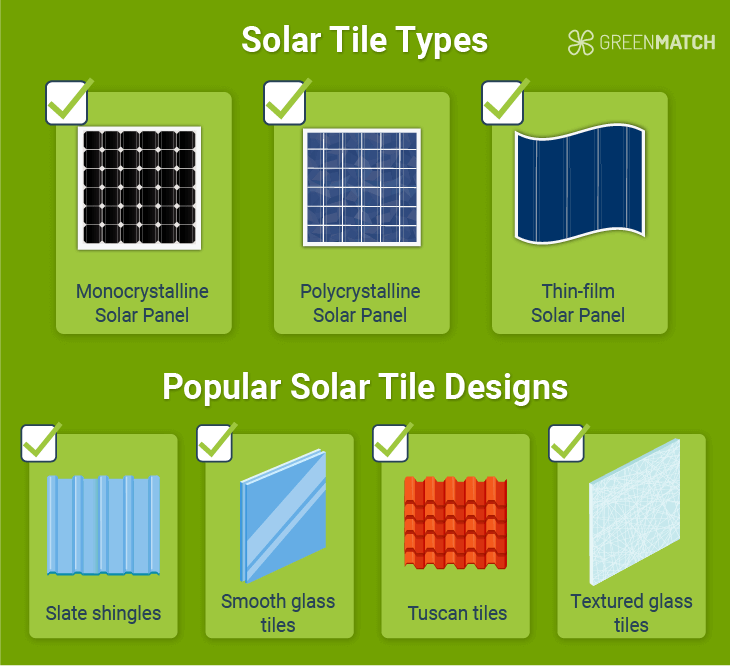
Solar tiles can vary in terms of the different types of solar panels used and the materials they are made of. A solar tile can consist of classic monocrystalline solar cells or thin-film photovoltaic cells. Monocrystalline panels are the most efficient and powerful but cannot be moulded into elaborate shapes.
| Types of solar panels | |||
|---|---|---|---|
| Solar cell type | Efficiency rate | Advantages | Disadvantages |
| Monocrystalline Solar Panels (Mono-SI) | ~20% | High efficiency rate; optimised for commercial use; high lifetime value | Expensive |
| Polycrystalline Solar Panels (p-Si) | ~15% | Lower price | Sensitive to high temperatures; lower lifespan & slightly less space efficiency |
| Thin-Film: Amorphous Silicon Solar Panels (A-SI) | ~7-10% | Relatively low costs; easy to produce & flexible | shorter warranties & lifespan |
Solar roof tiles come in various designs to suit different architectural styles while providing renewable energy. Here's a brief overview of the most common types:
-
Slate Shingles
These are designed to mimic traditional slate roofs, these tiles provide a hand-crafted appearance often seen on European-style homes. They blend best with classic roofing aesthetics. -
Smooth Glass Tiles
Featuring a sleek, modern look, these tiles are ideal for contemporary homes, especially high-end properties built in recent years. Their clean-cut design complements minimalist and futuristic architecture. -
Tuscan Tiles
Inspired by ancient Greek and Roman roofing styles, Tuscan tiles recreate traditional European wave tiles. They are part of Tesla’s solar roof range and are particularly suited for Mediterranean-style homes. -
Textured Glass Tiles
Perfect for historic buildings and traditional homes, textured glass tiles have the aesthetic of older buildings, so they are often chosen for preserving the appearance of historic properties.
Best solar roof brands in the UK
| Brand | Energy capacity | Cost | Warranty |
|---|---|---|---|
| GB Sol | 28-30W per PV slate | PV Slate units cost £225/sqm or £6,520.00 for a 4kW system. | PV Slate comes with a 25-year warranty on its product, solar performance, and weatherproofing. |
| Tesla | 13.5 kWh usable capacity | £6,300 - £9,000 | 10 years |
| XO Edge | 12W per tile | Not specified. | 25 Years 80% Power Output12 Years 90% Power Output3 Years Material & Workmanship |
When exploring solar roof tile options, a few manufacturers stand out for their innovation and suitability for different needs.
Tesla Solar Tiles are globally renowned for their cutting-edge technology and sleek design. Tesla’s Solarglass Roof offers durability with a 10-year warranty, comparable to traditional solar panels.
These tiles are versatile, available in various sizes, and are particularly suited for new builds. As part of Tesla’s renewable ecosystem, these tiles work well with the company’s solar batteries and energy management systems, offering a holistic solar solution.
GB Sol Solar Tiles, a UK-based manufacturer, specialises in PV Slate. It's designed to blend with slate roofs to preserve the charm of classic homes. GB Sol offers its products with a 25-year warranty.
Manufactured in Wales, these weather-resistant tiles are a cost-effective and locally produced choice.
XO Edge Solar Tiles, manufactured in London and made from recycled plastics, are among the lightest on the market and boast aerospace-grade UV resistance and durability.
XO Edge emphasises environmental impact, claiming their installations can become carbon-negative within six months. With sleek black or silver finishes, these tiles are an ideal option for those who value a modern aesthetic.
Overall, GB Sol provides the best deal, with a 25-year warranty, weather-resistant tiles with high durability, and a great cost-to-quality ratio. When looking at manufacturers and solar panel warranties, here is some advice from our expert consultant:
“A solar photovoltaic system is a long-term investment. Homeowners should seek warranties for at least 20 years. Most manufacturers offer at least this much with guaranteed power outputs at certain benchmark years. Another consideration for warranties is the ability of a company to pay.”

Joshua M. Pearce is the John M. Thompson Chair in Information Technology and Innovation. He holds appointments at Ivey Business School and the Department of Electrical & Computer Engineering at Western University. He runs the Free Appropriate Sustainability Technology research group.
Pros and cons of solar roof tiles
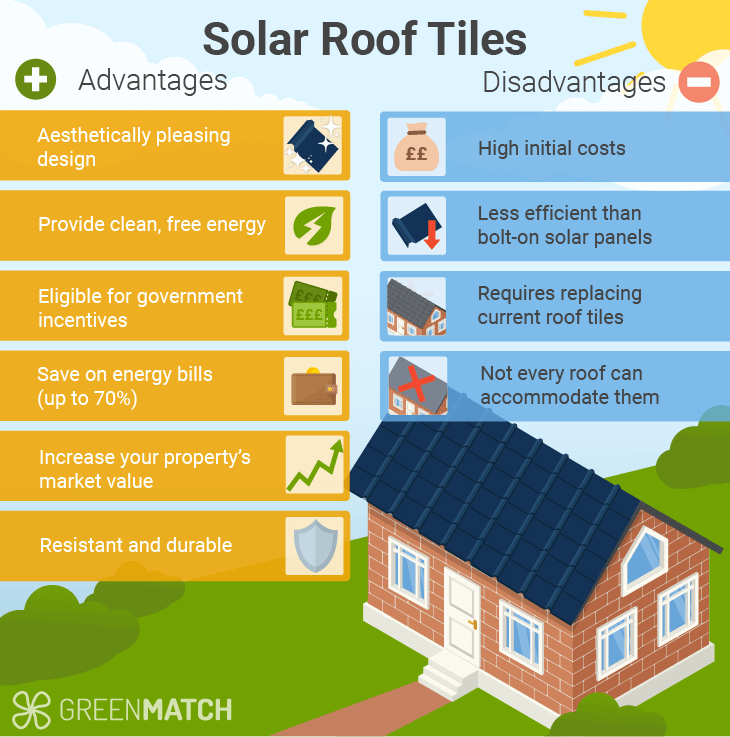
Advantages of solar roof tiles
Domestic solar technologies have many advantages in general, especially in terms of saving energy and protecting the environment. Below, we have listed the main benefits of solar tiles.
- Aesthetically pleasing design: This is likely the most significant advantage of this technology. You won’t have to cover your roof with huge solar panels and, therefore, won’t disrupt your house style. Moreover, there are different types of tiles to accommodate different roof and tile styles.
- Provide clean, free energy: Like solar panels, solar roof tiles are an eco-friendly alternative for powering all your house’s electric appliances. They are also eligible for the same government incentives as solar panels (e.g. the Energy Company Obligation Scheme – ECO4).
- Save on energy bills: Using a solar roof tile system, you can save between 40% and 70% on electricity bills, that's between around £265 - £460 based on our estimates.
- Increase your property’s market value: An aesthetically pleasing look and the current high demand for green energy combined will increase the value of your property, by 6.2% to 6.8%, according to a study done by Solar Energy UK.
- Increased resistance and durability: Bolt-on solar panels and solar roof tiles can last decades. However, extreme weather conditions can damage the former. Solar tiles, on the other hand, are often produced to be as durable as the roof itself, and even hurricane-force winds would not rip them off. Solar slates will even protect the roof section they are installed on.
Disadvantages of solar roof tiles
Of course, solar roof tiles have downsides, too. Here is an overview of their disadvantages:
- High initial costs: The purchase cost of solar slates is much higher than that of regular roof tiles. They can be twice as expensive as solar panel systems with similar wattage.
- Less efficient than bolt-on solar panels: On average, solar tiles’ efficiency is 10-20%. Most solar panels have an efficiency of at least 16%, sometimes even 22%, meaning you'll likely make greater savings with traditional solar panels.
- Requires replacing current roof tiles: Solar tiles are better for new buildings or those in which all tiles will be replaced. In contrast, traditional solar panels can be installed, uninstalled, and reinstalled fairly easily.
- Not every roof can accommodate them: A roof must be pitched and angled to be suitable for solar roof tiles. Once again, solar panels are relatively easier to install on ‘difficult’ roofs, including flat roofs.
Conclusion: Are solar roof tiles worth it?
Solar slates can be the right choice if you are looking for a visually appealing option for your home. You will also need a roof with the appropriate angle for absorbing sunlight that faces southward. Solar slates and roof tiles come in a variety of options that can maintain the aesthetics of your home. They integrate into the roof and are made from resistant and durable materials.
On the other hand, tiles can be a more expensive option and are less efficient than bolted-on solar panels. The annual savings range between £783 and £1,304, so the £13,000 to £16,200 price may not be worth it for everyone if they live in a 2 to 3-bedroom house. However, for some, the aesthetics might be worth it, or they may live in a conservation area where regular solar panels might disrupt the home’s design.
They are also less efficient than their solar panel counterparts, which means they will take up more space per kW. Solar tiles are also more difficult to install. If these drawbacks do not worry you, solar tiles may be the ideal choice.
Solar panels, on the whole, are more versatile and easier to install. They offer more variety since they have been around longer. Solar panels can also be easier to obtain planning permission for along with having lower installation costs since they bolt onto the roof.
- Quotes from local engineers
- Payment by finance available
- Save up to £1,567 per year
It only takes 30 seconds



Frequently asked questions
While solar roof tiles are not as widely available in the country as solar panels are. A few brands already operating in the UK market are GB Sol, Solecco, and Nulok Roofing System.
The lifespan of solar tiles can vary depending on the manufacturer and specific product, but generally falls between 25-30 years.
Solar roof tiles cost in the UK can be twice as much as that of solar panels. On average, you would pay £8,050 for a 1kW system and £16,200 for a 4kW system (including VAT and labour costs).
Solar panels are better than solar tiles in terms of cost, efficiency, and ease of installation. However, solar tiles integrate into roofs better and come in a variety of shapes and designs.

Rawal Ahmed is a writer at GreenMatch with an interest in sustainability and a background in tech journalism and digital marketing.

We strive to connect our customers with the right product and supplier. Would you like to be part of GreenMatch?

- Quotes from local engineers
- Payment by finance available
- Save up to £1,567 per year
It only takes 30 seconds




